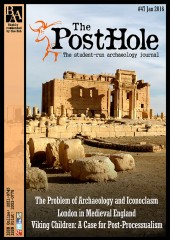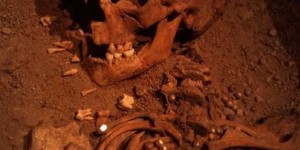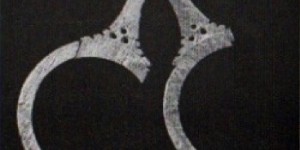The destruction of archaeological sites is not a modern phenomenon. Indeed, in Ancient times Julius Caesar is recorded as having burnt over “400,000”1 of the scrolls present in the Library of Alexandria, during the Roman Civil war of 49 BCE when Caesar was hunting down Pompey the Great. As he was outnumbered in enemy territory, he ordered the “ships in the harbour to be set on fire”2, and the fire spread to the library. This, however, is only one of the several theories regarding the disappearance of the Alexandrian library. Another theory states that the downfall of the library is linked to an “economic decline”3 in Ptolemaic Egypt.
There are more recent attempts to create gaps in our record of the past. The Nazis tried to erase written evidence with their infamous book burnings, resulting in the destruction of about “10,000”4 non-German books and the persecution of their authors5. However, the real inspiration for this article, was the destruction of Nimrud by ISIS. It was upsetting to watch a site destroyed within a couple of minutes, but I believe we can learn from the ruination of Nimrud. Later in this article I hope to suggest how we can protect archaeological sites from the same fate.
As it is, the artefacts being stored in various museums have prevented the complete loss of Nimrud. We can still learn about the site from its surviving artefacts.
In order to understand the loss of Nimrud, we must first understand the history behind the site. Once “the capital of the great Assyrian state that collapsed in the late seventh century”6, it was “first excavated in the mid-19th century”7, and then again in the 20th century8. Therefore, even though ISIS have destroyed the site of Nimrud, we can learn from this and prevent further tragedies.
Nimrud was destroyed with “sledgehammers, a bulldozer, and explosives”9. Whilst Nimrud is the main focus of this article, there have been other, less well-known sites which have been targeted by ISIS. One of these is the world heritage site of Hatra10, a military fortress that was founded in the first century BCE by the Arsacid dynasty11. It was significant as an “important trade and religious centre and was the site of the main Shamash temple”12. It was destroyed in the mid-third century by the Sasanians during their war with the Romans, though the ruins of the town had survived and were deemed a world-heritage by UNESCO13. There are many sites like these that are largely unheard of, and whose history should be more widely taught before they share the same fate as Hatra and Nimrud at the hands of ISIS.
One simple but crucial move we need to make is to condemn the actions of ISIS. The head of UNESCO has said “I condemn with the strongest force the destruction of the site at Nimrud”14. Furthermore, Irina Bokvo goes on to say that she “calls on all political and religious leaders in the region to stand up and remind everyone that there is absolutely no political or religious justification for the destruction of humanity’s cultural heritage”15.
While condemning the actions of ISIS is a step forward in the protection of archaeological sites, there are more actions we can take. One of these actions is to support the “#unite4heritage”16 project, which aims to “share the values of tolerance, diversity and respect”17. I believe this will help show that we as people are united against the actions of ISIS, and will help to promote the protection of archaeological sites.
Archaeological legislation and guidelines are in place which help to protect sites. However, it didn't protect Nimrud. One possible solution could be to put in place guards to try and limit the damage ISIS can do to high priority sites. This would not be ideal, and probably extremely difficult, but it may be a necessity in order to stop ISIS doing the same to other sites.
However, many archaeological sites in Syria are already protected by guards. Working for the Directorate General of Antiquities and Museums (DGAM), a government agency, these guards have primarily worked to combat looting. In some recent cases, the DGAM guards themselves were held at gun point by some looters18. There is a “15-year jail sentence”19 but this doesn’t appear to stop any looting. However, the Directorate general of antiquities and museums (DGAM) seized 1300 looted items in April 201220, demonstrating that there is some progress in stopping the looters and preventing the destruction of archaeological sites. This brings up the question of why people continue to plunder archaeological sites in spite of the 15-year jail sentence21, a possible explanation for which could be the culture of collecting. There many people who think that “collecting archaeological art is regarded as signifying an educated taste”22, and whilst this attitude seems harmless, it is supporting the destruction of archaeological sites as they are often destroyed in the process of looting. For example, the 6,000 classic Maya polychrome vessels that were removed from Guatemala and Mexico23, means that “thousands of burials have been destroyed in the process of obtaining these saleable objects”24. Looting is one of the most serious threats that archaeological sites face, and perhaps one of the ways of combatting this is to reduce the popularity of this culture.
UNESCO say that they will “constantly monitor the illicit traffic of stolen antiquities”25, which could be a step-forward, as illicit antiquity trade has been happening in various countries for centuries. There are examples of such illicit trading in the UK, such as the “Batheaston hoard or hoards.”26 In this case there were about 301 bronze artefacts excavated from south Wiltshire without any permission, and these are likely to have been from a scheduled ancient monument27. This shows that there are problems in this country that are unheard of due to the particular focus of looting in foreign countries. It may help if UK looting was given more coverage by the media, to make the problem seem more relevant in everyday life.
Furthermore, in protecting archaeological sites, UNESCO has been teaching people about heritage.1600 students have been invited to a guided tour of either the world heritage archaeological sites of Lebanon or in the national museum28. This is an important step forward, as whilst UNESCO’s highest priority is to protect sites, it is also important to teach people about their heritage and thus make them more inclined to aid in its protection.
However, while that remains a problem, UNESCO has started to deal further with preventing the destruction of archaeological sites. A task force29 has been designed to deal with this. This taskforce will “update and monitor the state of conservation of damaged and endangered historic and archaeological sites and monuments”30. This demonstrates that there have been developments since the destruction of Nimrud, with more efforts being made to protect endangered sites. Furthermore, satellite archaeology can be seen to combat this problem, as archaeologist Dr. Sarah Parcak has been using it to monitor the destruction of ancient sites31. This suggests that if UNESCO utilised satellite archaeology, it could be used to prevent the destruction of sites. However, there are of course limitations to this- satellites “traditionally produce low resolution imagery”32 creating a problem because “Low resolution imagery can only detect the larger archaeological structures”33. As a result, sites which do not fit the scale will not be detected. This therefore suggests that satellite imagery would be ideal for protecting the larger archaeological sites if utilised with the right amount of resources, although it could potentially leave the smaller sites unprotected.
To conclude, it can be seen that there is much we can learn from the destruction of the Nimrud. While it is a sad and ultimately unjust fate for the ancient archaeological site, it has been noted that artefacts have been preserved in certain museums, meaning that younger generations will be able to learn about the site. However, it must be remembered that the destruction of Nimrud is not an isolated incident. There are several less famous sites that have been destroyed due to either war or extremism. Archaeologists should bear in mind the other sites which have been destroyed, and should do what is possible to fill the gaps in the archaeological record. Therefore, while the destruction of archaeological sites is lamentable, these sites may have served to prompt UNESCO to take action. The organisation seems to be moving forward; their #unite4heritage campaign is helping to recreate memories of sites and spreading awareness of world-heritage sites in order to combat the threats of ISIS in a non-violent way. Furthermore, they sincerely wish to stop looting, protect sites, and reduce the destruction of archaeological sites. However, it must be remembered that so far, this sincerity is all they have. Progress will be seen in their actions.
Bibliography
- (2006) Available at: http://www.penn.museum/documents/publications/expedition/pdfs/24-3/mille... (Accessed: 9 January 2016).
- Antiquity journal (no date) Available at: http://www.antiquity.ac.uk/projgall/cunliffe333/ (Accessed: 16 January 2016).
- Blakemore, E. and @heroinebook, F. (2015) UN: Destroying the ancient city of Nimrud was a ‘War Crime’. Available at: http://www.smithsonianmag.com/smart-news/un-destroying-ancient-city-nimr... (Accessed: 16 January 2016).
- Brodie, N. (2000) Stealing history: The illicit trade in cultural material. United Kingdom: McDonald Institute for Archaeological Research.
- Johnson, S. (2015) 2016 TED Prize awarded to pioneering satellite archaeologist. Available at: http://uscar.usc.edu/?p=1431 (Accessed: 13 January 2016).
- Malm, S. and Press, A. (2015) Video: Islamic state group destroys ancient ruins of Nimrud. Available at: http://www.dailymail.co.uk/news/article-3035534/Video-Islamic-State-grou... accessed 08/01/2016 (Accessed: 16 January 2016).
- Nimrud objects at Cambridge’s museum of archaeology and anthropology (2015) Available at: http://oracc.museum.upenn.edu/nimrud/catalogues/ukmuseums/maacambridge/i... (Accessed: 9 January 2016).
- Pavlidis, L. (2005) High resolution satellite imagery for archaeological application. Available at: http://mariamagic.donatecharity.net/science-technology/High-Resolution-S... (Accessed: 13 January 2016).
- Photograph and Danti, M. (2015) Why ISIS hates archaeology and blew up ancient Iraqi palace. Available at: http://news.nationalgeographic.com/2015/04/150414-why-islamic-state-dest... (Accessed: 16 January 2016).
- Salkin, R. M. and Schellinger, P. E. (1996) International dictionary of historic places: Volume 1-5. Edited by Trudy Ring and Noelle Watson. Chicago: Fitzroy Dearborn Publishers.
- Stead, I. M. (2000) The Salisbury hoard. United Kingdom: The History Press.
- The burning of the library of Alexandria (no date) Available at: http://ehistory.osu.edu/articles/burning-library-alexandria (Accessed: 27 July 2015).
- The destruction of the great library of Alexandria (2014) Available at: http://www.ancient-origins.net/ancient-places-africa-history-important-e... (Accessed: 27 July 2015).
- The rise and fall of Nimrud (no date) Available at: http://www.historytoday.com/mark-ronan/rise-and-fall-nimrud (Accessed: 27 July 2015).
- Unite4 (no date) Available at: http://www.unite4heritage.org/ (Accessed: 16 January 2016).
- Welle, D. (2001) Library of burned books to recall Nazi Barbarism / culture / DW.COM / 15.05.2006. Available at: http://www.dw.com/en/library-of-burned-books-to-recall-nazi-barbarism/a-... (Accessed: 27 July 2016).
- (no date) Available at: https://en.unesco.org/sites/default/files/urgent_response_final_eng.pdf (Accessed: 12 January 2016).
- (no date) Available at: http://www.bede.org.uk/library.htm (Accessed: 16 January 2016).
- (no date) Available at: http://www.theguardian.com/world/2015/mar/06/isis-destroys-ancient-assyr... Date accessed 04/08/2015 (Accessed: 16 January 2016).
Citations, Quotes & Annotations
- (2006) Available at: http://www.penn.museum/documents/publications/expedition/pdfs/24-3/mille... (Accessed: 9 January 2016).
(2006) - Antiquity journal (no date) Available at: http://www.antiquity.ac.uk/projgall/cunliffe333/ (Accessed: 16 January 2016).
(Antiquity journal, no date) - Blakemore, E. and @heroinebook, F. (2015) UN: Destroying the ancient city of Nimrud was a ‘War Crime’. Available at: http://www.smithsonianmag.com/smart-news/un-destroying-ancient-city-nimr... (Accessed: 16 January 2016).
(Blakemore and @heroinebook, 2015) - Brodie, N. (2000) Stealing history: The illicit trade in cultural material. United Kingdom: McDonald Institute for Archaeological Research.
(Brodie, 2000) - Johnson, S. (2015) 2016 TED Prize awarded to pioneering satellite archaeologist. Available at: http://uscar.usc.edu/?p=1431 (Accessed: 13 January 2016).
(Johnson, 2015) - Malm, S. and Press, A. (2015) Video: Islamic state group destroys ancient ruins of Nimrud. Available at: http://www.dailymail.co.uk/news/article-3035534/Video-Islamic-State-grou... accessed 08/01/2016 (Accessed: 16 January 2016).
(Malm and Press, 2015) - Nimrud objects at Cambridge’s museum of archaeology and anthropology (2015) Available at: http://oracc.museum.upenn.edu/nimrud/catalogues/ukmuseums/maacambridge/i... (Accessed: 9 January 2016).
(Nimrud objects at Cambridge’s museum of archaeology and anthropology, 2015) - Pavlidis, L. (2005) High resolution satellite imagery for archaeological application. Available at: http://mariamagic.donatecharity.net/science-technology/High-Resolution-S... (Accessed: 13 January 2016).
(Pavlidis, 2005) - Photograph and Danti, M. (2015) Why ISIS hates archaeology and blew up ancient Iraqi palace. Available at: http://news.nationalgeographic.com/2015/04/150414-why-islamic-state-dest... (Accessed: 16 January 2016).
(Photograph and Danti, 2015) - Salkin, R. M. and Schellinger, P. E. (1996) International dictionary of historic places: Volume 1-5. Edited by Trudy Ring and Noelle Watson. Chicago: Fitzroy Dearborn Publishers.
(Salkin and Schellinger, 1996) - Stead, I. M. (2000) The Salisbury hoard. United Kingdom: The History Press.
(Stead, 2000) - The burning of the library of Alexandria (no date) Available at: http://ehistory.osu.edu/articles/burning-library-alexandria (Accessed: 27 July 2015).
(The burning of the library of Alexandria, no date) - The destruction of the great library of Alexandria (2014) Available at: http://www.ancient-origins.net/ancient-places-africa-history-important-e... (Accessed: 27 July 2015).
(The destruction of the great library of Alexandria, 2014) - The rise and fall of Nimrud (no date) Available at: http://www.historytoday.com/mark-ronan/rise-and-fall-nimrud (Accessed: 27 July 2015).
(The rise and fall of Nimrud, no date) - Unite4 (no date) Available at: http://www.unite4heritage.org/ (Accessed: 16 January 2016).
(Unite4, no date) - Welle, D. (2001) Library of burned books to recall Nazi Barbarism / culture / DW.COM / 15.05.2006. Available at: http://www.dw.com/en/library-of-burned-books-to-recall-nazi-barbarism/a-... (Accessed: 27 July 2016).
(Welle, 2001) - (no date) Available at: https://en.unesco.org/sites/default/files/urgent_response_final_eng.pdf (Accessed: 12 January 2016).
(no date) - (no date) Available at: http://www.bede.org.uk/library.htm (Accessed: 16 January 2016).
(no date) - (no date) Available at: http://www.theguardian.com/world/2015/mar/06/isis-destroys-ancient-assyr... Date accessed 04/08/2015 (Accessed: 16 January 2016).
(no date)
Footnotes
1 (no date) Available at: http://www.bede.org.uk/library.htm (Accessed: 27th July 2016).
2 The burning of the library of Alexandria (no date) Available at: http://ehistory.osu.edu/articles/burning-library-alexandria (Accessed: 27 July 2015).
3 The destruction of the great library of Alexandria (2014) Available at: http://www.ancient-origins.net/ancient-places-africa-history-important-e... (Accessed: 27 July 2015).
4 Welle, D. (2001) Library of burned books to recall Nazi Barbarism / culture / DW.COM / 15.05.2006. Available at: http://www.dw.com/en/library-of-burned-books-to-recall-nazi-barbarism/a-... (Accessed: 27 July 2016).
5 Ibid
6 The rise and fall of Nimrud (no date) Available at: http://www.historytoday.com/mark-ronan/rise-and-fall-nimrud (Accessed: 27 July 2015).
7 Ibid
8 Ibid
9 Photograph and Danti, M. (2015) Why ISIS hates archaeology and blew up ancient Iraqi palace. Available at: http://news.nationalgeographic.com/2015/04/150414-why-islamic-state-dest... (Accessed: 16 January 2016).
10 Malm, S. and Press, A. (2015) Video: Islamic state group destroys ancient ruins of Nimrud. Available at: http://www.dailymail.co.uk/news/article-3035534/Video-Islamic-State-grou... accessed 08/01/2016 (Accessed: 16 January 2016).
11 Salkin, R. M. and Schellinger, P. E. (1996) International dictionary of historic places: Volume 1-5. Edited by Trudy Ring and Noelle Watson. Chicago: Fitzroy Dearborn Publishers.
12 Ibid
13 Ibid
14 (no date) Available at: http://www.theguardian.com/world/2015/mar/06/isis-destroys-ancient-assyr... Date accessed 04/08/2015 (Accessed: 16 January 2016).
15 Blakemore, E. and @heroinebook, F. (2015) UN: Destroying the ancient city of Nimrud was a ‘War Crime’. Available at: http://www.smithsonianmag.com/smart-news/un-destroying-ancient-city-nimr... (Accessed: 16 January 2016.
16 Unite4 (no date) Available at: http://www.unite4heritage.org/ (Accessed: 16 January 2016).
17 Ibid
18 Antiquity journal (no date) Available at: http://www.antiquity.ac.uk/projgall/cunliffe333/ (Accessed: 16 January 2016).
19 Ibid
20 Ibid
21 Ibid
22 (2006) Available at: http://www.penn.museum/documents/publications/expedition/pdfs/24-3/mille... (Accessed: 9 January 2016).
23 Ibid
24 Ibid
25 (no date) Available at: https://en.unesco.org/sites/default/files/urgent_response_final_eng.pdf (Accessed: 12 January 2016)
26 Stead, I. M. (2000) The Salisbury hoard. United Kingdom: The History Press cited in Brodie, N. (2000) Stealing history: The illicit trade in cultural material. United Kingdom: McDonald Institute for Archaeological Research.
27 Ibid
28 http://unite4heritage.org/news/1600-lebanese-students-to-learn-about-her... Date accessed 06/01/2016
29 (no date) Available at: https://en.unesco.org/sites/default/files/urgent_response_final_eng.pdf (Accessed: 12 January 2016)
30 Ibid
31 Johnson, S. (2015) 2016 TED Prize awarded to pioneering satellite archaeologist. Available at: http://uscar.usc.edu/?p=1431 (Accessed: 13 January 2016).
32 Pavlidis, L. (2005) High resolution satellite imagery for archaeological application. Available at: http://mariamagic.donatecharity.net/science-technology/Hig
33 Ibid







